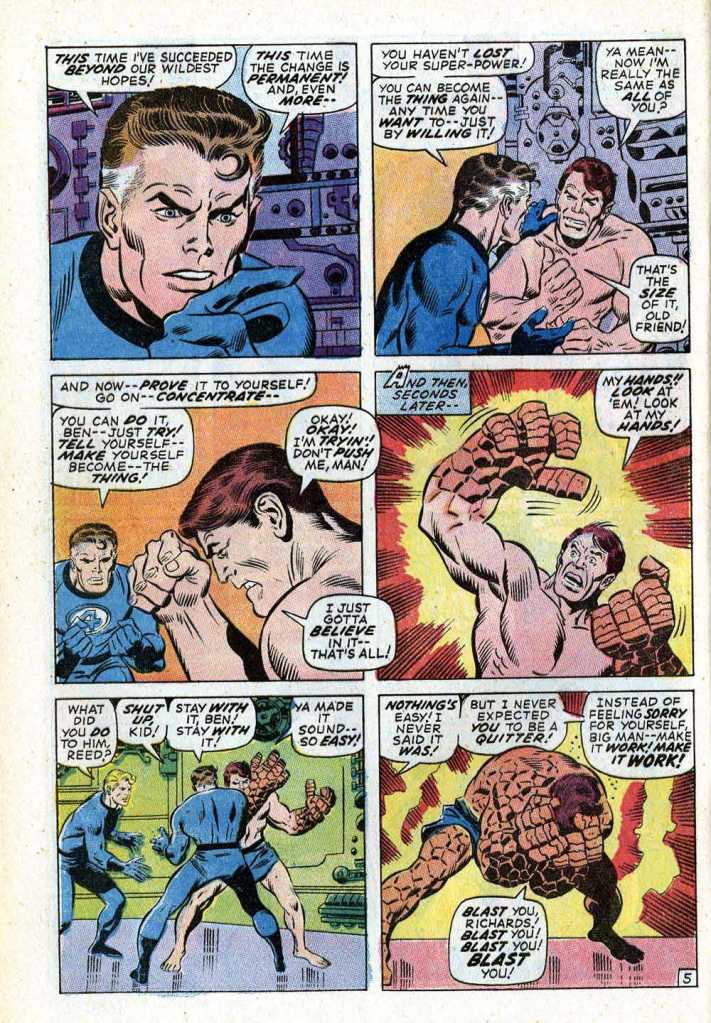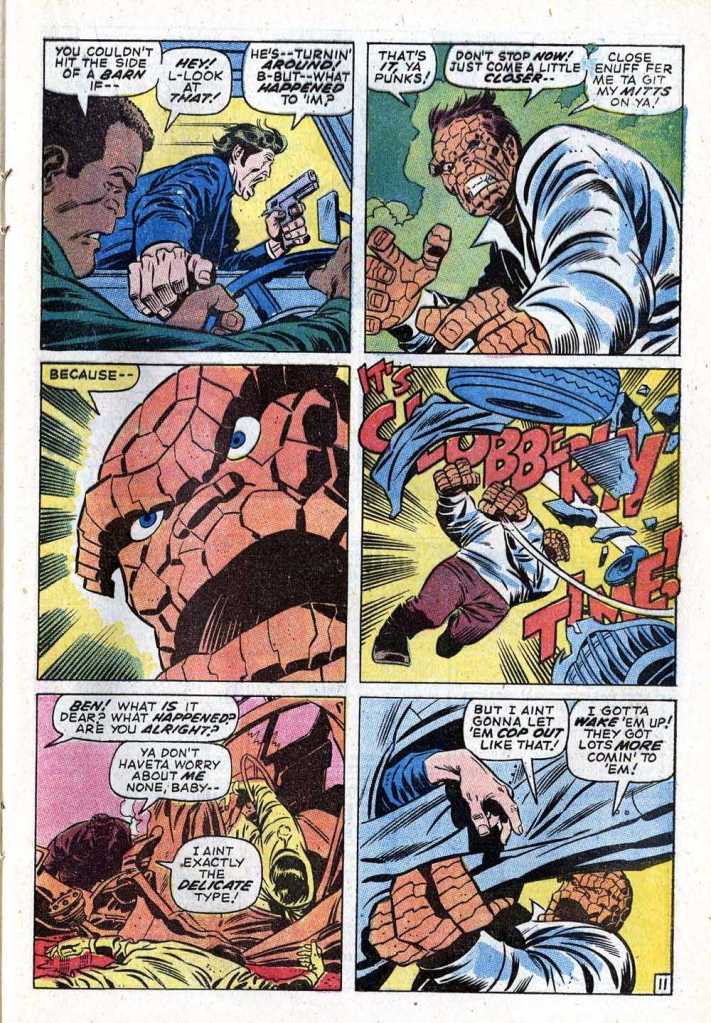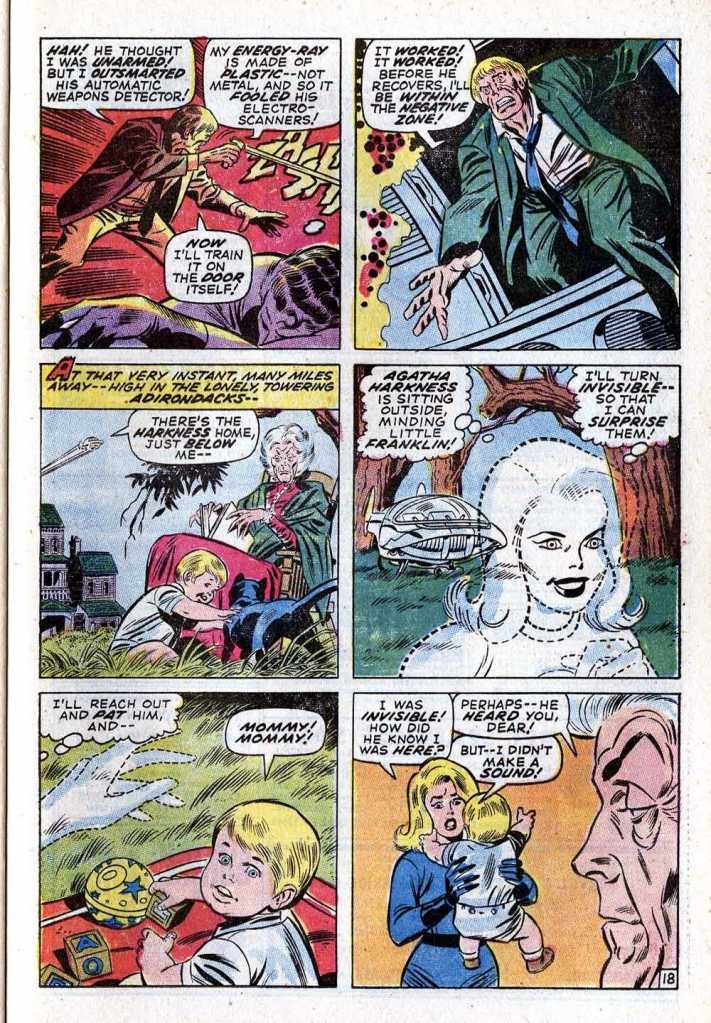
So as I’ve related before, it came out at some point that the branch of the Chase Manhattan Bank that my father worked out of was situated in the Levittown Mall–the same Mall that contained the first comic book shop that I ever went to, Heroes’ World. What this amounted to in practice is that, form time to time, my Dad would agree to stop into Heroes World on his way home and get me some comics. This was typically a reward for doing yardwork and things of that nature. I can recall vividly giving him long and byzantine lists of issue numbers and requesting certain titles. I had bought the Olshevsky Official Marvel Index to the Fantastic Four during my first Heroes’ World venture, and there were any number of covers within it that called to me. This cover was one of them. And so it was that my Dad brought this issue home for me one evening, semi-unexpectedly. I don’t know that I truly appreciated his efforts at the time, but I do today.

FANTASTIC FOUR was my favorite comic book at this particular moment, and this issue came out just as the series was at a crisis point. Jack Kirby, the real guiding force of the series for some time, had departed Marvel a couple of months earlier to seek out better opportunities at rival DC Comics. Marvel’s quasi-art director John Romita asked editor Stan Lee what was going to happen with the book–John assumed that it would be cancelled, that nobody could follow Kirby on it–and was shocked and terrified to be told that he would be taking it over. Romita only produced four issues, and while they were solid enough, they weren’t great. In part, this was because John felt constrained in having to follow Kirby’s approach. He’s talked about having Kirby pages all around him as he drew, and swiping as much as he could from them. Making the mission even harder, for some reason Joe Sinnott was taken off the strip, and John Verpoorten inked three of the four Romita issues. This meant that even the finish of the title felt different. Verpoorten’s work wasn’t bad, but it wasn’t Sinnott’s ultraslick line. Romita was a good soldier doing the work that had to be done, but he clearly wasn’t enjoying doing it.

Fortunately, there was somebody else in the Marvel Bullpen to whom Lee could turn–and with this issue, he did so. John Buscema had been perfecting his synthesis of Kirby and Romita’s work for a year or two now. He’d worked in the field during the 1950s but left in the wake of the crackdown on the comics field and went into advertising. In the mid-1960s, Lee’s ability to offer halfway decent rates allowed him to lure Buscema back to the fold–but while Big John was one of the finest and most accomplished draftsmen the world of comic books ever knew, he didn’t initially understand the kind of arch dramatics that the New Marvel style called for. Like many others, he did a story or two over Jack Kirby layouts, and immediately internalized the approach. So good was John Buscema as a Marvel artist that he ultimately wrote the book on it: How To Draw Comics The Marvel Way, in 1978.

So John Buscema became the mainstay artist on fANTASTIC FOUR for the next couple of years. And sales began to go up. (Kirby had been largely phoning in his work for the last year or so of his time on the title, which no doubt impacted on the sales.) What’s more, the characters were suddenly alive again. John imbued them with vitality and personality. He kept the Kirby-style dramatics but made the draftsmanship all his own. What’s especially funny about all of this is that, by his own admission, Buscema wasn’t a fan of super hero comics and didn’t like drawing them. He’d much rather have been doing a western, or a barbarian series, or a jungle adventure. But even with his reticence, he was a top-flight super hero artist at this point, and his arrival turned the fortunes of what was still seen as Marvel’s flagship book completely around. The fact that Joe Sinnott was back in saddle alongside John was the other big shift at this time. Sinnott’s finishing style was so strong and his grasp in the characters so exact that he could ink them over just about anybody and they would look right.

So what was going on in the story? Glad you asked. Last issue, Reed had begun yet another experiment to cure the Thing of his monstrous condition, only to be forced to halt the process in order to deal with another crisis. The Human Torch put Ben Grimm into suspended animation by drawing all of the heat within the room into his own body–but now, the danger has passed and Reed can finish what he’d begun. And this time, his process works to perfection. In fact, not only is Ben cured of being the Thing, but even better, he can transform himself back into his stony form simply by concentrating, in the same manner that Johnny could Flame On or Sue could go invisible. This would seem to be the best of all possible worlds, but there are misgivings right from the start. Ben’s personality begins to shift slightly. He becomes a bit nastier, a bit crueler–not enough where his teammates notice the change at first, but certainly his longtime girlfriend Alicia realizes something is wrong after Ben almost kills a team of hijackers whos path they cross.

But that situation is a matter for another day. Because in the meantime, Reed gets a visit from a strange man named Janus, who wants to venture into the Negative Zone. Reed tells Janus that the Zone is simply too dangerous to be entered, but Janus zaps Reed with a concealed weapon, opens the airlock to the Zone, and goes through. There’s a strange caption indicating that Janus is a new character even though Reed already knows him, and that all will be revealed. The reason for this caption is that, before he left Marvel, Jack Kirby had drawn one more Fantastic Four story, based on a plot idea from Lee. But the end result wasn’t to Lee’s liking, and so the book was pulled. As you can guess, it featured Janus, in the guise of a new villain, the Mega-Man. The issue after this one, #108, would in fact repurpose big chunks of that unfinished issue, with additional bridging material provided by Buscema and John Romita. Some people over the years have claimed that this was done in order to have a new Jack Kirby book on the stands the same month that his new DC product came out, but that’s always seemed far-fetched to me, given the amount of advance notice and coordination that would be needed, and the non-return it would bring. No, I think this was simply a case of using up some inventory material that had already been bought and paid for.

In any event, Janus would be recast as the Nega-Man, and the source of his power connected to that of the Negative Zone. Him having gone into the Zone represents an enormous danger to mankind, and Reed and the boys really have no other choice than to pursue him into that hostile environment and drag him back out. To Be Continued! I had been fascinated by the idea that there was a period in which the Thing could change back and forth at will, and as much as anything, that’s why I coveted this issue so much, to see how it all played out. The whole thing became a classic Marvel epic that moved from story to story to story, as the Negative Zone adventure (and the return of Annihilus) gave way to a Thing vs Hulk battle, which transitioned into the otherworldly threat of the Overmind and a team-up with Doctor Doom. While any number of the moves and ideas were familiar from earlier stories, this sequence of issues had great energy. These comics moved! It’s really no wonder that the book returned to its former luster during this period.

Interestingly enough, the header on the Fantastic Four Fan Page in this issue still tells readers to address their communications to Lee and Kirby–apparently, somebody forgot to update it for a while. And indeed, there is one letter which does so, while another addresses Stana nd John (Romita) and a third is directed solely at Stan. I don’t know what this all means per se, I’m simply pointing it out. Also still in use were the Hallowed Ranks of Marveldom, an idea proposed in a letter by Mark Evanier that awarded certain ranks to fans for having accomplished particular goals as regards Marvel. Stan loved these sorts of ways to encourage reader connection with Marvel, and these ranks hung around as a thing for quite some time.

So, not to open a can of worms, but… I think you and I are on the same page as far as Stan’s importance and capabillities in those early years. I have been reading more and more stories about Stan Lee could never wrote anything, couldn’t write and stole credit from everyone when it was needed. As the writer of the Alter Ego article on Stan Lee’s writing before 1962, I have a different view. I gues I can savely express that here without being struck down. Still, some decent historians are joining the chorus which at the very least is making me wonder. But when I read this, I thought: If Jack kirby had been doing the actual writing on the Fantastic Four and Stan just translated Jack’s notes, who wrote the John Buscema stories? Buscema himself bever showed any sign of being able to craft superhero stories (or even like them). So did Stan step up? Or did he buy stories from someone else who was never named? Were they structurally decent stories? What do you think?
LikeLike
Well, both Roy Thomas and Gerry Conway have spoken about helping to come up with plots for FANTASTIC FOUR stories during this period. And it’s not as though Buscema would have needed all that much guidance to put together an issue’s worth of penciling. I do think Stan often is attributed too much credit for the stories/plotting on the books he worked on. By that same token, as you mention , it’s not as though Stan was ever doing nothing, as some would like to believe.
LikeLiked by 3 people
By 1970, the year I turned 8, I already held the Fantastic Four as my favorite comic and among my original comics collection I had issues 101-106. Then, in early 1971, my dad (in the Navy at the time), was transferred from Long Beach, CA, to Salt Lake City (for recruiting duty) and in the move nearly all my old comics were thrown out. And at any rate, for whatever reason, I got very few comics between late 1970 and May 1972. The next month I got FF #126 (Thomas’ 1st). The next year, my 5th grade teacher happened to have FF #107 on his desk, and I asked about it and he gave it to me (and I still have it!), so I finally got to read the conclusion to the cliffhanger I’d read in106, although I’d lost that particular comic (but got the reprinted version in Marvel’s Greatest Comics years later).
Anyhow, as an 8 year old, I don’t even recall making note of the change in artist from issue 102 to 103 — it all still looked good to me and I don’t think I was paying that close attention to the artists just yet. Then again, looking back from an adult perspective and knowing that Romita was purposely aping Kirby’s style, just as he’d aped Ditko’s during the first several months after taking over drawing Spider-Man, it’s not surprising I didn’t take note of the change right away. Romita did a good enough job, certainly, but as you mentioned, Buscema brought a much greater dynamism to the art and Sinnott’s return on inks restored a bit of the old look. One big difference — Sue suddenly looked far more gorgeous, under both Romita and Buscema. Not to say she looked bad as drawn by Kirby (and inked by Sinnott!), but Kirby’s women (and men) tended to look more cartoonish, while the more illustrative qualities of Romita’s and Buscema’s styles made them look more real and much more attractive (unless they specifically drawn to look grotesque). And Buscema could draw a very mean looking Ben Grimm, especially when transforming into the Thing. And I think that although Buscema had learned to adopt Kirby’s dynamism, his own unique style was dominant and he clearly didn’t feel any need to try to ape Kirby as Romita did.
Also, from what I’ve read elsewhere, Buscema preferred bare-boned plots to more detailed ones. He wasn’t bubbling over with more ideas than he could contain, as seemed the case with Kirby in his prime, but he was adept enough at crafting a good story even with minimal directions but likely required more plot input from Lee than was the case with Kirby & Ditko. And it occurs to me that while Lee had been writing nearly the entire line of Marvel superhero titles by latter part of 1965, seems he began cutting back in 1966, assigning X-Men and Avengers to Thomas, although taking back Dr. Strange just after Ditko left. With the expansion of 1968, Lee relinquished more series, to Thomas, et. al., and even more in 1970 (in response to Kirby’s departure?), until finally he was down to just the FF and Spider-Man, aside from one last Dr. Strange story when that series was relaunched with plot and art by Barry Smith, before relinquishing regular comics writing altogether when he took over as publisher.
1973 was the first year I really began collecting several titles each month, so I wasn’t really paying attention to the changes occurring over the years, but having read enough reprints and back issues from the Silver Age, it’s very apparent that even by late 1972, the Marvel Universe was a very different place from what it had been just 5 years earlier — and 5 years before that it was still emerging from it’s post Atlas era cocoon (if the Timely years are regarded as it’s caterpillar stage).
LikeLiked by 2 people
“The dreaded Negative Zone.” One of the unfortunate things about the MU and DCU is that just as powers tend to increase over time, things that were once terrifying alien become more mundane. The Negative Zone gradually went from being a nightmarish world where entry put you at risk of life to just a strange, slightly alien place. Dan Slott’s Silver Surfer gave Eternity a life partner. I suppose it’s inevitable but I hate it.
LikeLiked by 1 person
Rereading the Silver Age Marvels it’s struck me how Kirby’s Hulk was very much a monster book (not a new thought) and Ditko’s revival series was much more a mid-sixties superhero book.
LikeLiked by 1 person
Reed to Johnny: “Shut up, kid!” Reed to Ben: “But I never expected you to be a QUITTER!” Dang, Stan. Reminds me of Shooter having Reed goad Bruce Bannner as the Hulk while Hulk was holding up the mountain dropped on them in “Secret Wars”, knowing “the madder Hulk gets, the stronger Hulk gets”.
J. Buscema’s impact on comics must have been seismic. It’s documented even by himself that he had to, as written above, “synthesize” Kirby & Romita, Sr.’s styles. But his skill and knowledge was unique @ that point. Bo-legged, athletic men with developed physiques, and voluptuous women in the model of Taylor & Monroe. Dynamic for sure.
LikeLiked by 2 people